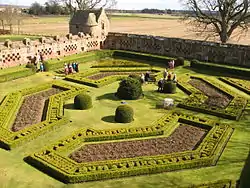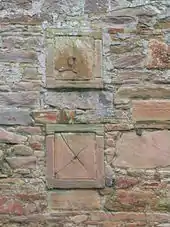Walled garden
A walled garden is a garden enclosed by high walls for horticultural rather than security purposes, although originally all gardens may have been enclosed for protection from animal or human intruders. In temperate climates, the essential function of the walls surrounding a walled garden is to shelter the garden from wind and frost, though they may also serve a decorative purpose.

Creation of microclimates

The shelter provided by enclosing walls can raise the ambient temperature within a garden by several degrees, creating a microclimate that permits plants to be grown that would not survive in the unmodified local climate.
Most walls are constructed from stone or brick, which absorb and retain solar heat and then slowly release it, raising the temperature against the wall, allowing peaches, nectarines, and grapes to be grown as espaliers against south-facing walls as far north as southeast Great Britain and southern Ireland.
The ability of a well-designed walled garden to create widely varying stable environments is illustrated by this description of the rock garden in the Jardin des Plantes in Paris’ 5ème arrondissement, where over 2,000 species from a variety of climate zones ranging from mountainous to Mediterranean are grown within a few acres:
The garden is protected from sudden changes in weather conditions and from harsh winds, thanks to its hollowed out terraces and the big trees …. The gardeners make the most of the northern or southern exposures and the permanently shady areas of this little, sheltered valley. Within just a few metres, temperatures can range from 15 to 20 degrees C, what one would call a micro-climate![1]
Heated walls
A number of walled gardens in Britain have one hollow wall with openings in the stonework on the side facing towards the garden, so that fires could be lit inside the wall to provide additional heat to protect the fruit growing against the wall. Heat would escape into the garden through these openings, and the smoke from the fires would be directed upwards through chimneys or flues. This kind of hollow wall is found at Croxteth Hall in Liverpool (England), and Eglinton Country Park and Dunmore House, both in Scotland. In the 1800s, such walls were lined with pipes and connected to a boiler, as at Bank Hall in Bretherton.
Design
The traditional design of a walled garden, split into four quarters separated by paths, and a wellhead or pool at the centre, dates back to the very earliest gardens of Persia. The hortus conclusus or "enclosed garden" of High Medieval Europe was more typically enclosed by hedges or fencing, or the arcades of a cloister; though some protection from weather and effective protection from straying animals was afforded, these were not specifically walled gardens.
Kitchen gardens
In the United Kingdom, many country houses had walled kitchen gardens which were distinct from decorative gardens. One acre of a kitchen garden was expected to provide enough produce to feed twelve people, and these gardens ranged in size from one acre up to twenty or thirty acres depending on the size of the household.[2] The largest gardens served extremely large households, for example, the royal kitchen garden at Windsor was built for Queen Victoria in 1844 and initially occupied twenty two acres, but was enlarged to thirty one acres to supply the growing household.[3] Kitchen gardens received their greatest elaboration in the second half of the nineteenth century.[4] Many of these labor intensive gardens fell into disuse in the twentieth century, but some have been revived as decorative gardens, and others used to produce fruits, vegetables or flowers.
Susan Campbell, in a book devoted to walled kitchen gardens, mentions several factors which contribute to how productive a kitchen garden is. Productivity depended upon the suitability of the situation, and successful gardens depended on the availability of water, manure, heat, wall space, storage space, workrooms, and most importantly, a dedicated team of gardeners.[2]
Examples
British examples of walled gardens can be found at Alnwick Castle, Castle Bromwich Hall Gardens, Fulham Palace, Goodnestone Park, Luton Hoo, Polesden Lacey, Shugborough Hall, and Trengwainton Garden in England; Bodysgallen Hall (Wales); Edzell Castle, Muchalls Castle and Myres Castle (Scotland).
The walled kitchen garden at Croome Court, Worcestershire is reputedly the largest 18th-century walled kitchen garden in Europe. It is in private ownership and has been restored by the current owners. In about 1806, a 13 ft (4.0 m) high free-standing east–west hot wall was built, slightly off-centre, serviced by five furnaces; this is historically significant as it is one of the first such structures to be built.[5][6]
The walled kitchen garden at Chilton Foliat, Wiltshire, was the subject of the 1987 television documentary series The Victorian Kitchen Garden.

In literature
In the story of Susanna and the Elders, a walled garden is the scene of both an alleged tryst and an attempted rape. Because of the walls, the community is unable to determine which actually occurred.
In John William Waterhouse's interpretation of the myth of Cupid and Psyche, Psyche lived in Cupid's walled garden.
Much of the storyline of Frances Hodgson Burnett's children's story The Secret Garden revolves around a walled garden which has been locked for ten years.
"Rappaccini's Daughter", a short story by Nathaniel Hawthorne, takes place almost entirely within the confines of a walled garden in which Beatrice, the lovely daughter of a mad scientist, lives alongside gorgeous but lethal flowers.
In The Last Enchantment, the third book in Mary Stewart's novels of the Arthurian legend, Merlin constructs a heated wall for his garden at Applegarth.
See also
 Media related to Walled gardens at Wikimedia Commons
Media related to Walled gardens at Wikimedia Commons
References
- Rodolphe Trouilleux, Unexplored Paris. Paris: Parigramme, 1996, 2009, p. 61
- Susan Campbell, Walled Kitchen Gardens. Oxford: Shire Publications, 2013 (1998), p. 5.
- Susan Campbell, Walled Kitchen Gardens. Oxford: Shire Publications, 2013 (1998), p. 6.
- Susan Campbell, A History of Kitchen Gardening; Jennifer Davies, The Victorian Garden (1987, based on a BBC series)
- Tovey, Jill (Archivist for the Croome Estate Trust) (2011), A Summary of the History of Croome Walled Garden, Friends of Croome Park
- Historic England. "Garden Wall to Walled Garden to East of Croome Court and Gardener's Cottage in NW Corner (1349527)". National Heritage List for England. Retrieved 2 March 2017.
Further reading
- Walled Kitchen Gardens - Susan Campbell - Google Books
- The Elements of Organic Gardening: Highgrove, Clarence House, Birkhall - HRH Charles Prince of Wales, Stephanie Donaldson - Google Books
- Garden Plants for Scotland - Kenneth N. E. Cox, Raoul Curtis Machin - Google Books
- The Roman Frontier in Central Jordan: Final Report on the Limes Arabicus ... - S. Thomas Parker - Google Books
- Heaven - Randy C. Alcorn - Google Books
- The Hidden Places Of Ireland - David Gerrard - Google Books
- Georgina Campbell's Ireland for Garden Lovers - Georgina Campbell, Marianne Heron - Google Books